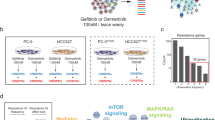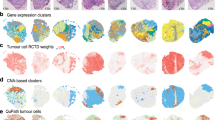Abstract
A 44-year old woman with recurrent solitary fibrous tumor (SFT)/hemangiopericytoma was enrolled in a clinical sequencing program including whole-exome and transcriptome sequencing. A gene fusion of the transcriptional repressor NAB2 with the transcriptional activator STAT6 was detected. Transcriptome sequencing of 27 additional SFTs identified the presence of a NAB2-STAT6 gene fusion in all tumors. Using RT-PCR and sequencing, we detected this fusion in all 51 SFTs, indicating high levels of recurrence. Expression of NAB2-STAT6 fusion proteins was confirmed in SFT, and the predicted fusion products harbor the early growth response (EGR)-binding domain of NAB2 fused to the activation domain of STAT6. Overexpression of the NAB2-STAT6 gene fusion induced proliferation in cultured cells and activated the expression of EGR-responsive genes. These studies establish NAB2-STAT6 as the defining driver mutation of SFT and provide an example of how neoplasia can be initiated by converting a transcriptional repressor of mitogenic pathways into a transcriptional activator.
This is a preview of subscription content, access via your institution
Access options
Subscribe to this journal
Receive 12 print issues and online access
$209.00 per year
only $17.42 per issue
Buy this article
- Purchase on Springer Link
- Instant access to full article PDF
Prices may be subject to local taxes which are calculated during checkout




Similar content being viewed by others
Accession codes
References
Roychowdhury, S. et al. Personalized oncology through integrative high-throughput sequencing: a pilot study. Sci. Transl. Med. 3, 111ra121 (2011).
Ruiz, C. et al. Advancing a clinically relevant perspective of the clonal nature of cancer. Proc. Natl. Acad. Sci. USA 108, 12054–12059 (2011).
Welch, J.S. et al. Use of whole-genome sequencing to diagnose a cryptic fusion oncogene. J. Am. Med. Assoc. 305, 1577–1584 (2011).
Park, M.S. & Araujo, D.M. New insights into the hemangiopericytoma/solitary fibrous tumor spectrum of tumors. Curr. Opin. Oncol. 21, 327–331 (2009).
Gold, J.S. et al. Clinicopathologic correlates of solitary fibrous tumors. Cancer 94, 1057–1068 (2002).
Srinivasan, R., Mager, G.M., Ward, R.M., Mayer, J. & Svaren, J. NAB2 represses transcription by interacting with the CHD4 subunit of the nucleosome remodeling and deacetylase (NuRD) complex. J. Biol. Chem. 281, 15129–15137 (2006).
Svaren, J. et al. NAB2, a corepressor of NGFI-A (Egr-1) and Krox20, is induced by proliferative and differentiative stimuli. Mol. Cell. Biol. 16, 3545–3553 (1996).
Svaren, J. et al. EGR1 target genes in prostate carcinoma cells identified by microarray analysis. J. Biol. Chem. 275, 38524–38531 (2000).
ENCODE Project Consortium. A user's guide to the encyclopedia of DNA elements (ENCODE). PLoS Biol. 9, e1001046 (2011).
McLean, C.Y. et al. GREAT improves functional interpretation of cis-regulatory regions. Nat. Biotechnol. 28, 495–501 (2010).
Hajdu, M. et al. IGF2 over-expression in solitary fibrous tumours is independent of anatomical location and is related to loss of imprinting. J. Pathol. 221, 300–307 (2010).
Subramanian, A. et al. Gene set enrichment analysis: a knowledge-based approach for interpreting genome-wide expression profiles. Proc. Natl. Acad. Sci. USA 102, 15545–15550 (2005).
Mosquera, J.M. & Fletcher, C.D. Expanding the spectrum of malignant progression in solitary fibrous tumors: a study of 8 cases with a discrete anaplastic component—is this dedifferentiated SFT? Am. J. Surg. Pathol. 33, 1314–1321 (2009).
Thiel, G. & Cibelli, G. Regulation of life and death by the zinc finger transcription factor Egr-1. J. Cell. Physiol. 193, 287–292 (2002).
Kumbrink, J., Gerlinger, M. & Johnson, J.P. Egr-1 induces the expression of its corepressor Nab2 by activation of the Nab2 promoter thereby establishing a negative feedback loop. J. Biol. Chem. 280, 42785–42793 (2005).
Kumbrink, J., Kirsch, K.H. & Johnson, J.P. EGR1, EGR2, and EGR3 activate the expression of their coregulator NAB2 establishing a negative feedback loop in cells of neuroectodermal and epithelial origin. J. Cell. Biochem. 111, 207–217 (2010).
Stacchiotti, S. et al. Sunitinib malate and figitumumab in solitary fibrous tumor: patterns and molecular bases of tumor response. Mol. Cancer Ther. 9, 1286–1297 (2010).
Aparicio, S.A. & Huntsman, D.G. Does massively parallel DNA resequencing signify the end of histopathology as we know it? J. Pathol. 220, 307–315 (2010).
Lonigro, R.J. et al. Detection of somatic copy number alterations in cancer using targeted exome capture sequencing. Neoplasia 13, 1019–1025 (2011).
Grasso, C.S. et al. The mutational landscape of lethal castration-resistant prostate cancer. Nature 487, 239–243 (2012).
Langmead, B. Aligning short sequencing reads with Bowtie. Curr. Protoc. Bioinformatics Chapter 11, Unit 11.7 (2010).
Iyer, M.K., Chinnaiyan, A.M. & Maher, C.A. ChimeraScan: a tool for identifying chimeric transcription in sequencing data. Bioinformatics 27, 2903–2904 (2011).
Robinson, D.R. et al. Functionally recurrent rearrangements of the MAST kinase and Notch gene families in breast cancer. Nat. Med. 17, 1646–1651 (2011).
Yu, J. et al. An integrated network of androgen receptor, polycomb, and TMPRSS2-ERG gene fusions in prostate cancer progression. Cancer Cell 17, 443–454 (2010).
Acknowledgements
The authors thank T. Barrette for hardware and database management, S. Birkeland, M. Pierce-Burlingame and K. Giles for assistance with sample and manuscript preparation and X. Jing for carrying out microarray experiments. We also thank the larger MI-ONCOSEQ team, including cancer geneticists S. Gruber and J. Innis; bioethicists J.S. Roberts and S.Y. Kim; genetic counselors J. Everett, J. Long and V. Raymond; and radiologists E. Higgins, E. Caoili and R. Dunnick. M. Quist performed initial SNV analysis. L. Sam, A. Balbin and P. Vats assisted with bioinformatics analysis. This project was supported in part by the National Cancer Institute (NCI) Early Detection Research Network (U01 CA111275), the National Functional Genomics Center (W81XWH-11-1-0520) and the US Department of Defense (A.M.C.). Additional infrastructure support was generously provided by the Prostate Cancer Foundation. The work was also supported in part by the US National Institutes of Health through the University of Michigan's Cancer Center Support Grant (5 P30 CA46592) and grants PO1 CA047179-15A2 (C.R.A. and S.S.) and P50 CA 140146-01 (C.R.A. and S.S.); the Linn Fund and Cycle for Survival (C.R.A.); the Alan Rosenthal Research Fund for research in sarcoma (C.R.A.); and the Weinstein Solitary Fibrous Tumor Research Fund (C.R.A.). A.M.C. is supported by the Doris Duke Charitable Foundation Clinical Scientist Award and a Burroughs Wellcome Foundation Award in Clinical Translational Research. A.M.C. is an American Cancer Society Research Professor and an A. Alfred Taubman Scholar.
Author information
Authors and Affiliations
Contributions
D.R.R., C.R.A. and A.M.C. conceived the experiments. D.R.R., Y.-M.W. and X.C. performed exome and transcriptome sequencing. S.K.-S. and M.K.I. carried out bioinformatics analysis of high-throughput sequencing data and nomination of gene fusions. R.J.L. carried out bioinformatics analysis of high-throughput sequencing data for gene expression, copy-number and tumor-content determination. Y.-S.S., C.-L.C., D.R.R., Y.-M.W. and F.S. isolated nucleic acids and performed PCR and Sanger sequencing experiments. Y.-M.W. and F.S. carried out gene fusion validations and gene fusion cloning. Y.-M.W., R.W., F.S. and D.R.R. carried out cell-based in vitro experiments and qPCR assays. L.Z. and C.-L.C. performed immunoblot and immunofluorescence experiments on tissue samples. J.S. collected and prepared tissue samples for next-generation sequencing. L.P.K., J.M.M. and C.R.A. provided pathology review. S.M.S. and S.S. provided the case samples and clinical data. S.R., K.J.P., M.T., S.K.-S., R.J.L., J.S., D.R.R., Y.-M.W., X.C. and A.M.C. developed the integrated clinical sequencing protocol. D.R.R., Y.-M.W., C.R.A. and A.M.C. prepared the manuscript, which was reviewed by all authors.
Corresponding authors
Ethics declarations
Competing interests
This manuscript was disclosed to the University of Michigan Office of Technology Transfer, which has filed a patent on the findings.
Supplementary information
Supplementary Text and Figures
Supplementary Figures 1–10 and Supplementary Tables 1–8 (PDF 30883 kb)
Rights and permissions
About this article
Cite this article
Robinson, D., Wu, YM., Kalyana-Sundaram, S. et al. Identification of recurrent NAB2-STAT6 gene fusions in solitary fibrous tumor by integrative sequencing. Nat Genet 45, 180–185 (2013). https://doi.org/10.1038/ng.2509
Received:
Accepted:
Published:
Issue Date:
DOI: https://doi.org/10.1038/ng.2509
This article is cited by
-
Unveiling the Rarity: A Case Report on Solitary Fibrous Tumor of the Thyroid Gland
Indian Journal of Otolaryngology and Head & Neck Surgery (2024)
-
Surgical considerations in the resection of solitary fibrous tumors of the pleura
Journal of Cardiothoracic Surgery (2023)
-
A review of solitary fibrous tumours of the orbit and ocular adnexa
Eye (2023)
-
Histopathologic Diagnosis of Sinonasal Tumors: Challenges and the Importance of Establishing the Correct Diagnosis
Current Otorhinolaryngology Reports (2023)
-
Top 10 Significant Spindled Head and Neck Lesions to Scrutinze
Head and Neck Pathology (2023)



